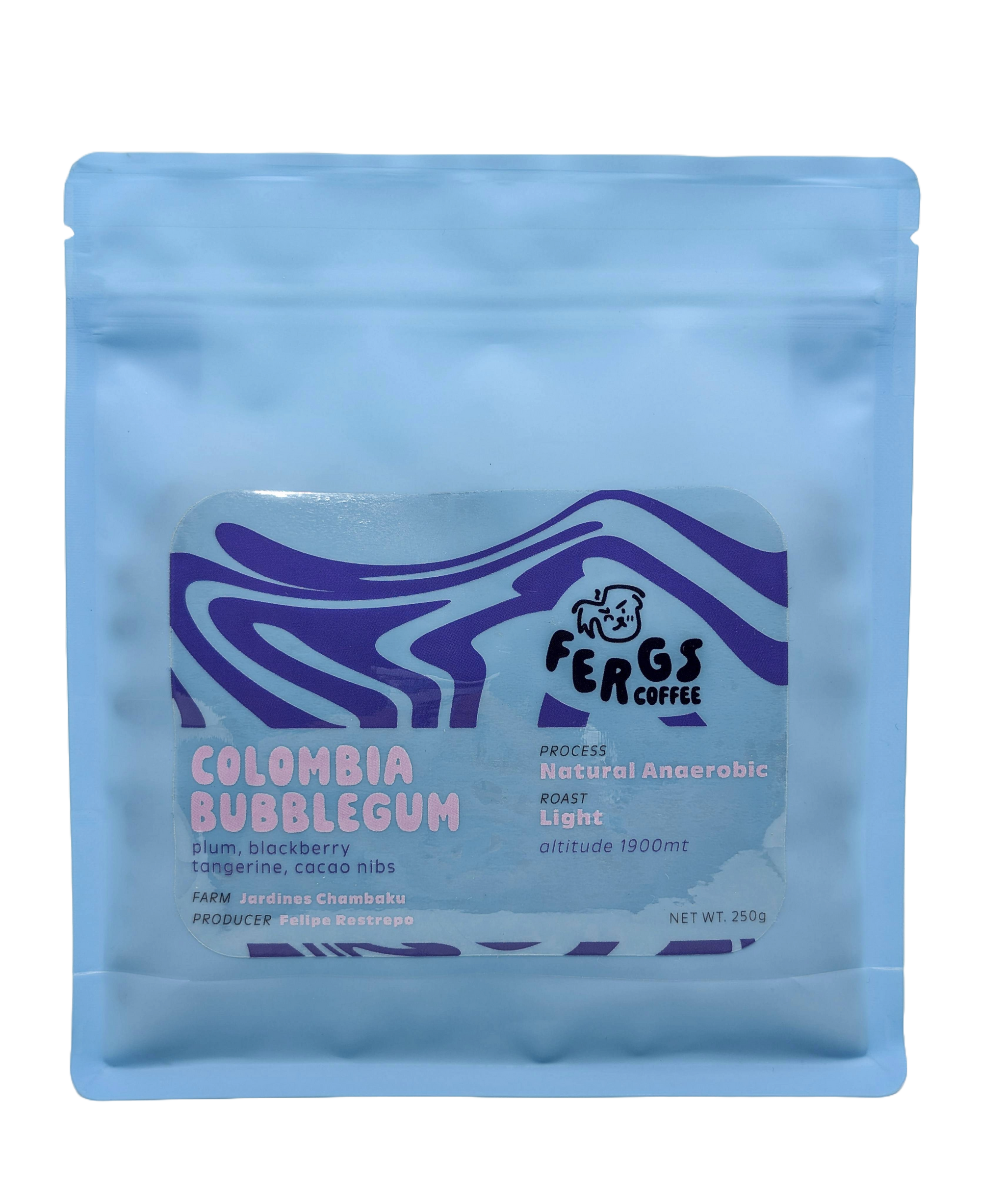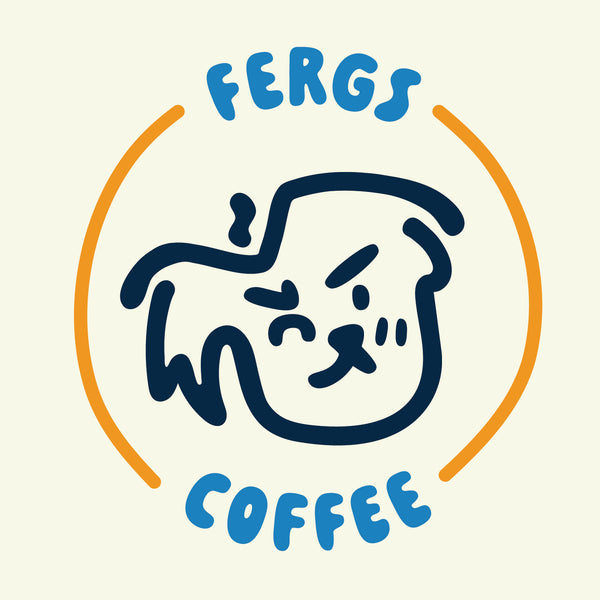Brewing Coffee at Home

So, you've got your hands on some Fergs Colombia Bubblegum coffee beans What's next? Let's dive into what we think is the best way to brew your beans. The best way is your way of course, but we are here to help guide you!
PRE-COFFEE MAKING
Step 1: Fetch your gear!
Before you start brewing, make sure you have everything you need.
We recommend brewing with anything that uses percolation or drip method. Find a brewer such as: Hario V60, Kalita Wave, April Brewer, or even a generic automatic coffee brewer. Whatever floats your boat. Make sure to use the appropriate filters with whatever brewer you use.
If you choose to go with a pour over style brewer, make sure to find a mug that your pour over kit can easily sit on top of.
If you chose an automatic brewer, then you should have a coffee carafe.
Next, you need your scale. No need to get fancy with it. If you have a scale that is accurate to 0.1 grams, then great! If you don't, then find a kitchen scale. I personally use the DiFluid Smart Coffee Scale.
If your scale doesn't have a built in timer, then have your phones stop watch app ready (you will need it).
The biggest piece of equipment you'll need is probably a grinder. High quality grinders make a significant difference in your coffee brewing experience. There is always a point of diminishing returns, but in general, the more you spend on a quality grinder, the better quality of coffee you'll get in your cup. If you have the budget to spend, then do some research on good quality grinders within your said budget. Otherwise, the only grinder I'd recommend as an entry point for home brewing is the Baratza Encore. This will give you everything you need to start off.
If you want to be as precise and consistent as possible, use an Electric Kettle. Preferable one that has temperature control. If that's not possible, use a Goose Neck Kettle. You could find affordable goose neck kettles on amazon.
Last thing is water. Water is 98% of whats in your coffee. I will not get into water science or what water you should be using, but know that depending on the water you use, your experience will differ. I recommend you do a small amount of research and experiment with your daily brews to see what best works for you!
Laundry List: Coffee Brewer (Manual Brewer or Auto Brewer), Scale, Grinder, Vessel (Mug), Kettle, Water, Timer
Step 2: Mise en Place or whatever...
Get all your equipment set up and in place. You don't want to scramble looking for something you need while you are doing a manual brew. If you using an automatic brewer just plug that baby in and you are done.
Weigh out 20 grams of whole bean coffee and set aside.
Heat your water up to 205-210 F. If you don't have temperature control, then just let your water hit boiling point and remove from the heat. Wait 2-3 minutes so your water temperature drops.
While your water is heating, Place filter in coffee brewer (V60, Kalita, April Brewer, etc.). Place brewer on top of a mug or vessel.
Step 3: Grindin'
Use your grinder (not that grinder, put your phone away) to grind your 20 grams of Fergs Colombia Bubblegum Whole Bean Coffee. For your settings, you don't want the coffee to grind too "fine" or "small". You want it to be coarse enough to let water through, but not so coarse that your water doesn't extract all that coffee goodness as it passes through the coffee. Think of sand vs. pebbles. Too fine like sand and water will be absorbed. Too coarse like pebbles and the water will flow too fast through the pebbles. Check your grinder and it should have some recommended settings for pour overs or auto drip coffee makers. Those settings should yield decent results.
Step 4: About to po' it up
By now your water should be ready to pour, your coffee should be ground, and your coffee brewing setup should be set up. If it's not, then I lost ya somewhere on the way here and that's OK. Just start over!
For you automatic coffee dripper people, just dump your ground coffee into your filter inside of the filter basket. Press your start button and hope for the best. You are done. In a few min you'll either have the best cup of coffee of your life or something...not as good. But that's OK. Automatic coffee makers are hard to get right with non-commodity coffee. Change your grind size to see improvements. Experiment with different water. If your coffee is too thin and watery, make your grind size "FINER". If it's overly bitter and harsh, make your grind size "COARSER". Using a new coffee is never a sure shot right away. You need to experiment a little.
Back to my pour over peoples. Place your pour over setup on your scale. Pour your ground coffee in to your filter. Notice that the weight on your scale has gone up. WOW! That's OK. Tare your scale so that it "zero's out". Now you are back to 0 grams on your total weight. This means the only thing we are weight now is the...you guessed...THE WATER!
Use the water to wet the filter. This is optional, some claim that some filters give off paper flavor to their coffee. By wetting the filter you are getting rid of that. That same how water will also heat up your vessel so that your coffee doesn't cool down instantly the moment it touches the vessel. Make sure to dump the water out of the vessel before you start making coffee.
We are ready to acutally "po it up" now.
ACTUAL COFFEE MAKING
Step 1: First Pour
Pour your hot water over your coffee grounds in a circular motion starting from the center and moving outwards towards the edge of the filter. Pour in a steady and consistent flow. Do not rush the pour. Slowly and careful pour the water out and make sure all the grounds are wet.
Your coffee-to-water ratio will be 1:15 in this brew. That means for every 1 gram of coffee you will use 15 grams of water by the end of the brew. Welcome to math class. Because we are using a standard recipe of 20 grams, your total weight of liquid at the end of your brew will be 300 grams. That's your cup of coffee right there.
Pour 60 grams of water into your coffee grounds AND START YOUR TIMER. Why 60 grams? We use 3 times the amount of coffee in our filter for our first pour of water. Make sure to pour slow and steady. Don't pour too fast. You want the water to be distributed evenly. I recommend pouring in a slow and steady circular motion starting from the center of the ground coffee and then moving outwards too the edge of the filter. Once you pour 60 grams of water, wait 30-45 seconds for the water to draw down. If the water is not drawing down, that means your grind size is too FINE. Start over and grind coarser.
You will notice a lot of bubbles, if your coffee was roasted within 1-2 weeks. This is natural. Those bubble are gasses releasing from your coffee as you pour hot water on your grounds. Ideally, the less gas you have in the coffee, the better it will exhibit its natural flavors. At Fergs, we aim to let roasted coffee sit for at least 1 week before selling it.
Step 2: Second Pour
Once the water has been drawn down, pour 80 grams of water in the exact same way. NOT TOO SLOW, NOT TOO FAST. You want a steady stream of water. No droplets, no pours that cause splashes. No pours that agitate the coffee too much. Circular motion starting from the center and moving outwards towards the edge. Let the water draw down once again.
Step 3: Third Pour
Again, wait for the water to draw down. Once the water has drawn down, pour ANOTHER 80 GRAMS. NO WAY! But yes, exact same step as the previous step. But now if you look at the total weight of your pour over, its gone up. The total weight should now be 220 grams. If you check your timer, you'll notice that time has also passed! Woooo! It should be anywhere from 2-3 minutes at this point. It mainly depends on your grind size and how steady you pour your water. Anyways, let the water draw down.
Step 4: Final Pour
ANOTHER 80 GRAMS. In the exact same way as the last, pour 80 grams of water. This will bring your total weight to 300 grams. By the time all the water has drawn down your timer should be anywhere from 2.5 - 3.5 minutes. BOOM. You just birthed your first pour over. Congrats. Fergie is proud of you.
If your timer is past 3.5 minutes, your coffee might taste a bit astringent or harsh. If its under 2.5 minutes, it might be too watery and light. IT'S OK. Make the adjustments to your grind size and focus on how you pour your water. There's obviously more to it, but this is not a time or place to get all Bill Nye the Science guy on everyone. Enjoy the process, experiment with the coffee, and most of all have fun. That's what Fergs is all about.
-Ya Boy, Tito 2024
TLDR;
Standardized Recipe for anyone looking to enjoy a cup without worrying about all the extra science stuff.
Water Temp: 205-210F
Grind Size: "Medium - Medium Fine" (Like freshly cracked sea salt)
- Pour 60 grams wait 30 seconds
- Pour 80 grams wait for water to draw down
- Pour 80 grams wait for water to draw down
- Pour 80 grams wait for water to draw down
- Drank
-Fergs Loves Ya
